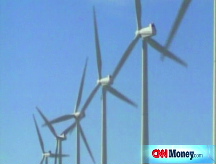Clearing the air on California emissions
The president may let the state regulate greenhouse gases - and effectively raise gas mileage standards. Is that the smartest way to go?
NEW YORK (CNNMoney.com) -- There was controversy earlier this week when President Obama decided to review California's request to tighten emissions standards - a move that may force a crippled auto industry to build cars that get better gas mileage.
Confusion, about what exactly Obama and California were doing, was apparent on the day of the announcement.
In fact, it's still unclear what the intentions of the administration are, and what effect California's proposed rules would have on the auto industry, the environment and consumers.
Contrary to some reports, California would not set its own fuel-efficiency standards. It, and the 16 other states that would likely follow it, would set new air pollution standards that are stricter than the federal government's, as they have done for the last several decades.
California needs a special waiver from the Environmental Protection Agency to set higher standards. The state has applied for this waiver dozens of times before, and it's always been granted.
But its most recent waiver request was denied by the Bush administration on grounds that new national fuel-economy standards made California's new rules unnecessary. Obama has now directed the EPA to review that decision.
While the waivers were always granted in the past, this most recent request raises new issues. What's different this time around is that California wants to regulate carbon dioxide, the main gas behind global warming, which is not a simple task.
Carbon dioxide cannot be simply captured from a car's tailpipe like a lot of other pollutants. The only way carmakers would be able to meet these new standards is by selling vehicles that get better gas mileage in those states. Cars that burn less gas emit less carbon dioxide - effectively raising mileage standards.
Industry supporters say it will be a disaster, with different mileage standards in different sates costing too much money and resulting in too many layoffs - especially in an economy wracked by recession.
"The effect of this policy will be to destroy American jobs at the very time government leaders should be working together to protect and create them," Rep. John Boehner (R-Ohio), said in a statement after the review was announced. "Millions of American jobs will be placed in further jeopardy if automakers are forced to spend billions to comply with potentially dozens of different emissions standards in dozens of different states."
They also say it may result in less car choice for consumers, as car companies may simply keep larger, more polluting vehicles off the market in states that enact the standards.
Environmentalists and others say the industry is merely using scare tactics to avoid the changes, which they say are relatively inexpensive and necessary if the industry is to make cars people want to buy in a world concerned with global warming.
"Detroit has been wasting time for 20 years," said Lee Schipper, a professor at the University of California Berkeley's Transportation Center.
Schipper pointed to groups like the Coalition for Vehicle Choice, an industry-funded lobby group, that spent millions fighting higher fuel standards, when the auto industry could have been putting that money to good use building more efficient cars.
But how much it would cost the industry to comply with stricter standards is a matter of debate.
The California Air Resources Board, the agency responsible for setting the standard, says cars could comply at an additional cost to the consumer of $1,000, at the most.
Others say it will cost far more.
If California is allowed to enact its proposed rules, the state estimates cars would have to get 42.5 miles a gallon by 2020. That's 7.5 more miles than the current federal target of 35 miles per gallon by 2020, and up from the current 27.5 miles a gallon.
California's push to regulate carbon dioxide is part of a nationwide trend. States are taking regulation of air pollution into their own hands because of what they perceive is inadequate action on behalf of the federal government. The Bush Administration resisted mandatory caps on carbon dioxide in favor of voluntary efforts by the industry.
In addition to California's efforts on the motor vehicle front, several Northeastern states banded together to regulate greenhouse gases from power plants last year.
It's unclear if Obama really wants the EPA to let California set its own standard, or if he's using the issue to drum up support for a national regulation on greenhouse gases - something he promised during his campaign but which will likely prove difficult to actually turn into law.
"I certainly have no idea what (Obama's) intentions were, but I think the practical result is that you just can't make cars for state-specific standards, you just cannot do that, and so what will happen is that all of those involved in the auto industry will soon be up here lobbying for a national standard," Sen. Bob Corker, (R-Tenn.) told the industry newsletter Environment & Energy Daily earlier this week. "Again, it just adds a constituent base for a national cap-and-trade program."
It's also prompted calls for what many say is an even simpler solution to air pollution and global warming than either higher state emission standards or a national restriction on carbon dioxide emissions: a straight-up tax on carbon that hits oil, coal and natural gas.
It's estimated such a tax would add $1 a gallon to the price of gasoline and $70 a month to the average heating bill, although it could be phased in over time and offset by reductions in other federal taxes, like the payroll tax.
"Contrary to all the popular cries for green transit or green energy, the way other countries have made things green is by carbon taxes," said Schipper. "We can't reduce carbon until we force carbon prices up." ![]()



